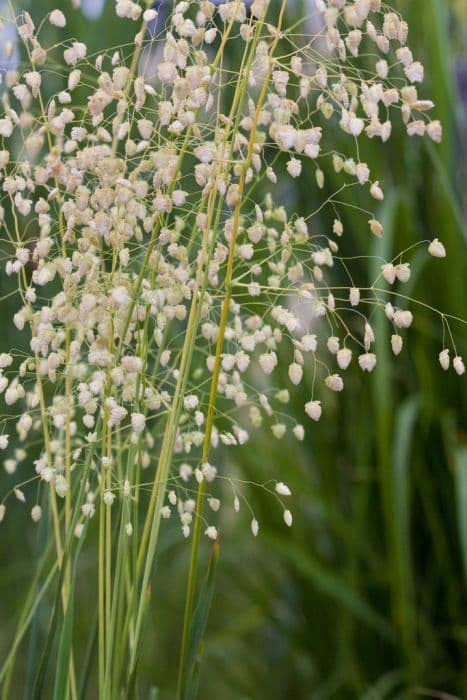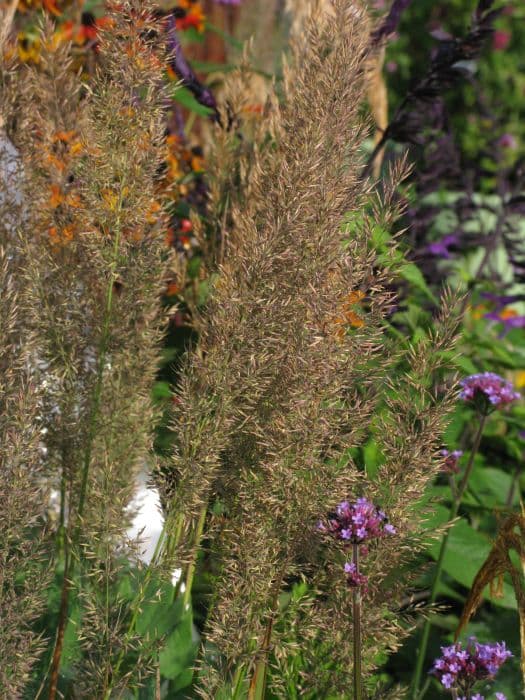Silver Feather Grass Stipa barbata

ABOUT
Stipa barbata, commonly known as silver feather grass or feather grass, is a perennial plant that is highly prized for its ornamental features. The plant is characterized by its graceful, slender leaves which can be green or grey-green in color. The leaves typically form a tufted mound that provides a soft texture to the landscape. The most striking feature of silver feather grass is its long, feathery awns that emerge from the flowering spikes. These awns are silvery or silky in appearance and can catch the sunlight, creating a shimmering effect that is particularly beautiful when swaying gently in the breeze. Each awn is delicate and thread-like, and at certain times of the year, they can give the plant an ethereal, almost glowing presence in gardens. Overall, silver feather grass has an elegant and airy look, making it a popular choice for gardeners who wish to add movement and a touch of whimsy to their plantings.
About this plant
 Names
NamesFamily
Poaceae
Synonyms
Silver Feather Grass, Feather Grass, Barbata Needle Grass, Mediterranean Feather Grass, Silky Spear Grass
Common names
Stipa capillata L. subsp. barbata (Michx.) Hyl., Stipa capillata var. barbata (Michx.) K. Richt.
 Toxicity
ToxicityTo humans
Stipa barbata, commonly known as Silver Feather Grass, is not widely recognized for any significant toxicity to humans. Ingesting this plant is unlikely to cause poisoning or toxic reactions in humans; however, as with any plant, individual allergies or sensitivities could possibly cause mild irritation or discomfort.
To pets
Silver Feather Grass does not have a well-documented toxicity to pets such as dogs and cats. Generally, ingestion of this plant should not be expected to cause poisoning. However, pets consuming large amounts of any non-food plant material may experience gastrointestinal upset, such as vomiting or diarrhea. It's always prudent to monitor pets if they consume this or any unfamiliar plant material, and consult a veterinarian if unusual symptoms occur.
 Characteristics
CharacteristicsLife cycle
Perennials
Foliage type
Deciduous
Color of leaves
Green
Flower color
Silver
Height
2 feet [60 cm]
Spread
6 inches [15 cm]
Plant type
Herb
Hardiness zones
7
Native area
Mediterranean
Benefits
 General Benefits
General Benefits- Landscape aesthetic: Stipa barbata, commonly known as Silver Feather Grass, adds a unique texture and visual interest to gardens with its feathery, silver-white plumes.
- Drought tolerance: Once established, Silver Feather Grass is highly drought-resistant, making it suitable for xeriscaping and water-wise gardening.
- Wildlife attraction: The plant provides habitat and food for wildlife, including birds that may use its fibers for nesting material.
- Minimal maintenance: Silver Feather Grass requires minimal care once established, other than occasional watering during prolonged dry spells.
- Erosion control: The deep root system of Stipa barbata helps to stabilize soil and prevent erosion, especially on slopes or in areas with loose soil.
- Seasonal interest: It offers year-round interest with changing colors and textures throughout the seasons—from vibrant green in spring to golden brown in fall and winter.
 Medical Properties
Medical PropertiesThis plant is not used for medical purposes.
 Air-purifying Qualities
Air-purifying QualitiesThis plant is not specifically known for air purifying qualities.
 Other Uses
Other Uses- Stipa barbata, commonly known as silver feather grass, can be used for artistic purposes, such as in floral arrangements or as a natural decor element in sculptures due to its delicate and visually appealing feathery plumes.
- The fibrous leaves of silver feather grass can be used in traditional crafting, such as making baskets, mats, or other woven items, showcasing its durability and texture.
- This plant can serve as a food source for grazing animals; the foliage, though not highly nutritious, can be consumed by livestock in regions where other forage is scarce.
- Due to its distinctive appearance, silver feather grass can be employed in landscape photography as a subject or a compositional element to enhance the depth and interest in natural scenes.
- It can be utilized as a natural dye, where the seeds and foliage of silver feather grass might impart subtle colors to textiles or other materials through traditional dyeing processes.
- The dried plumes of silver feather grass can be used in the creation of eco-friendly packing materials as an alternative to synthetic options, providing cushioning and protection for delicate items during shipping.
- Its ability to grow in poor soils makes silver feather grass useful for soil stabilization and erosion control in areas prone to land degradation.
- Used as a teaching tool in botany and plant morphology, silver feather grass can help students learn about the unique adaptations of grasses to different environments.
- This plant might serve as an indicator species in certain ecosystems, where its presence or absence could signal changes in environmental conditions or soil health.
- Silver feather grass can be incorporated into garden designs as a natural wind indicator due to the movement of its tall, swaying stems in the breeze.
Interesting Facts
 Feng Shui
Feng ShuiThe Silver Feather Grass is not used in Feng Shui practice.
 Zodiac Sign Compitability
Zodiac Sign CompitabilityThe Silver Feather Grass is not used in astrology practice.
 Plant Symbolism
Plant Symbolism- Resilience: Stipa barbata, commonly known as Silver Feather Grass, is symbolic of resilience due to its ability to thrive in arid conditions and withstand the challenges of a harsh environment.
- Gracefulness: The delicate and feathery appearance of Silver Feather Grass's plumes represents grace and elegance. The way the plumes sway in the wind can be seen as a dance with nature.
- Lightness: The fine texture and the silvery color of the grass capture the essence of lightness, symbolizing an unburdened spirit and a gentle touch.
- Adaptability: Silver Feather Grass is adaptable to various environments, symbolizing the plant's nimbleness and the ability to adjust to changing circumstances.
- Timelessness: As a perennial plant, Silver Feather Grass represents timelessness and endurance, embodying the capacity to last through the ages and seasons.
 Water
WaterFoxtail barley (Stipa barbata) is a drought-tolerant plant that requires minimal watering once established. It should be watered deeply and infrequently, about once a week during the active growing season, with approximately 1-2 gallons depending on the size of the plant and the soil moisture level. During the winter months, reduce watering to every few weeks or even less if rainfall provides sufficient moisture. Allow the soil to dry out between waterings to prevent root rot. Overwatering can be detrimental, so it is crucial to monitor the soil moisture regularly.
 Light
LightFoxtail barley thrives in full sun but can also tolerate partial shade. The best spot for this plant is an area that receives at least 6 to 8 hours of direct sunlight daily. It is well-suited for open spaces and sunny borders where it can bask in the sunlight, as this enhances its growth and the ornamental value of its feathery plumes. Avoid planting in deep shade, as this can weaken the plant and make it more susceptible to disease.
 Temperature
TemperatureFoxtail barley is tolerant of a wide range of temperatures but grows best at temperatures between 65°F and 75°F. The plant can survive minimum temperatures down to about 20°F and maximum temperatures well over 100°F. However, extreme cold or heat may affect the plant's growth and vigor, so it is ideal to maintain it within its preferred temperature range for optimal health and appearance.
 Pruning
PruningPruning of foxtail barley is predominantly done to remove spent flower stalks and to tidy up the plant. It is best to prune in late fall or early spring before new growth begins. Cut back the old foliage to about 2-3 inches above the ground to encourage fresh, new growth. Generally, once yearly pruning is sufficient for maintaining the plant's health and attractive appearance. Remove any dead or damaged stems as needed throughout the year.
 Cleaning
CleaningAs needed
 Soil
SoilSilver Feather Grass prefers well-draining soil with a slightly acidic to neutral pH, ranging from 6.0 to 7.0. A mix of loamy soil with sand is ideal to mimic its native growing conditions, ensuring good drainage and aeration.
 Repotting
RepottingSilver Feather Grass, being a hardy perennial, does not require frequent repotting. It should be repotted every 2-3 years or when it outgrows its current container, using a well-draining soil mix.
 Humidity & Misting
Humidity & MistingSilver Feather Grass does well in average humidity conditions seen in typical outdoor environments and does not require high humidity levels to thrive.
 Suitable locations
Suitable locationsIndoor
Provide full sun and well-draining soil.
Outdoor
Plant in full sun, well-drained soil; water sparingly.
Hardiness zone
7-11 USDA.
 Life cycle
Life cycleStipa barbata, commonly known as silver feather grass, begins its life cycle as a seed, which upon suitable environmental conditions such as adequate moisture and temperature, germinates and develops into a seedling. The plant then enters a vegetative stage where it grows long, slender leaves, and a deep root system that enables it to survive in its typically arid habitats. As it matures, silver feather grass transitions to the reproductive phase, producing tall, feathery flowering stalks that can reach up to 1 meter in height, with the distinctive long awns that facilitate seed dispersal by wind. After pollination, typically by wind, the flowers develop into seeds enclosed within spikelets. These seeds eventually detach from the parent plant and can lie dormant in the soil until conditions are favorable for germination, thus completing the plant's life cycle. Silver feather grass is a perennial, so it can survive for several years, repeating its reproductive cycle annually.
 Propogation
PropogationPropogation time
Spring to early summer
Propogation: The most popular method of propagation for Stipa barbata, commonly known as Silver Feather Grass or Feather Grass, is through seed. The optimal time for sowing Feather Grass seeds is in the spring, after the danger of frost has passed and when the soil temperature has warmed up sufficiently for seed germination. The seeds should be sown directly onto the surface of well-draining soil and should not be covered with soil as they require light to germinate. Watering should be gentle to avoid washing the seeds away, yet consistent enough to keep the soil moist until germination occurs, which generally takes about 2 to 3 weeks. Once the seedlings have developed and are large enough to handle, they can be thinned out or transplanted to their desired location in the garden.









